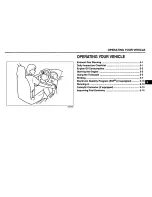
Adding Coolant
If you need more coolant, add the proper DEX-COOL
®
coolant mixture at the coolant recovery tank.
{
CAUTION:
Turning the radiator pressure cap when the
engine and radiator are hot can allow steam
and scalding liquids to blow out and burn you
badly. With the coolant recovery tank, you
will almost never have to add coolant at the
radiator. Never turn the radiator pressure
cap — even a little — when the engine and
radiator are hot.
Add coolant mixture at the recovery tank, but be careful
not to spill it.
{
CAUTION:
You can be burned if you spill coolant on hot
engine parts. Coolant contains ethylene glycol,
and it will burn if the engine parts are hot
enough. Do not spill coolant on a hot engine.
Occasionally check the coolant level in the radiator.
For information on how to add coolant to the radiator,
see Cooling System on page 5-32.
Radiator Pressure Cap
Notice: If the pressure cap is not tightly installed,
coolant loss and possible engine damage may
occur. Be sure the cap is properly and tightly
secured.
See Engine Compartment Overview on page 5-12 for
information on location.
Engine Overheating
You will find a coolant temperature gage on your
vehicle’s instrument panel. See Engine Coolant
Temperature Gage on page 3-36 for more information.
If your vehicle has a Driver Information Center (DIC),
the display will show an Engine Coolant Hot/Engine
Overheated message. See DIC Warnings and Messages
on page 3-48 for more information.
5-30
Summary of Contents for 9-7X
Page 74: ...NOTES 1 70...
Page 125: ...NOTES 3 3...
Page 126: ...Instrument Panel Overview 3 4...
Page 268: ...When you open the hood on the 5 3L V8 engine here is what you will see 5 14...
Page 270: ...When you open the hood on the 6 0L V8 engine here is what you will see 5 16...
Page 378: ...NOTES 5 124...
Page 393: ...Engine Drive Belt Routing 4 2L V6 Engine 5 3L V8 and 6 0L V8 Engines 6 15...
Page 412: ...NOTES 7 16...
















































